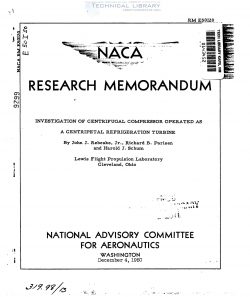naca-rm-e50i20
- Version
- 40 Downloads
- 857.53 KB File Size
- 1 File Count
- April 24, 2017 Create Date
- April 24, 2017 Last Updated
National Advisory Committee for Aeronautics, Research Memorandum - Investigation of Centrifugal Compressor Operated as a Centripetal Refrigeration Turbine

A centrifugal compressor from a production-type turboJet engine.
was successfully Operated as a centripetal refrigeration turbine over
a range of rotor speed, inlet pressure, and pressure ratio for'full
admission; with a constant inlet pressure, the unit was operated over
a range of rotor speed and pressure ratio for several degrees of perv
tial admission. Performance data are presented for a range of nominal
equivalent rotor speeds and pressure ratios. At a nominal equivalent
rotor speed of 6800 rpm, performance results are presented for various
turbine-inlet pressures (corresponding to percentages of throttling at
the turbine inlet) and several different degrees of partial admission.
From the foregoing performance results, partial admission was
concluded to be the more efficient method of turbine control, although
throttling at the turbine inlet was easier to apply.
A study of the possible cause of erosion of the nozzles and the
rotor observed during the inrestigation indicated that the nozzles
should have erosion-resistant surfaces to minimize this detrimental
effect.
An inrestigation was undertaken at the NASA Lewis laboratory to
determine whether a centrifugal-flow compressor from a production-type
turboJet engine could serve as an air-refrigeration unit in the labora-
tory service facilities when operated as a radial centripetal turbine.
The over-all turbine performance was investigated in terms of air-
temperature drop and adiabatic temperature-drop efficiency over a range
of rotor speeds, inlet-air pressures, pressure ratios (corresponding to
percentages of throttling at the turbine inlet), and degrees of partial
admission. It was desired to establish the best turbine operating speed
for maximum refrigeration effect, to evaluate partial admission and
inlet throttling as a possible means for controlling the air-temperature
drop and the air-weight flow through the unit, and to obtain information
on the practical aspects of operation of the unit.
A turboJet-engine centrifugal-flow compressor was therefore set up
and the air flow through the unit was reversed. so that it operated as a‘
centripetal refrigeration turbine. Performance data are presented in
terms of the variation in refrigerating effect (in Btu/sec), air horse-
power, temperature drop, weight flow, am. adiabatic efficiency with
various over-all pressure ratios for both inlet throttling and partial
admission.
| File | Action |
|---|---|
| naca-rm-e50i20 Investigation of Centrifugal Compressor Operated as a Centripetal Refrigeration Turbine.pdf | Download |

Comment On This Post